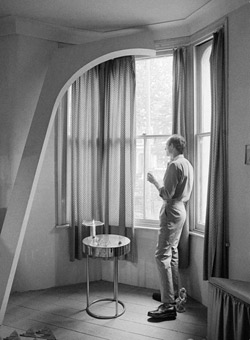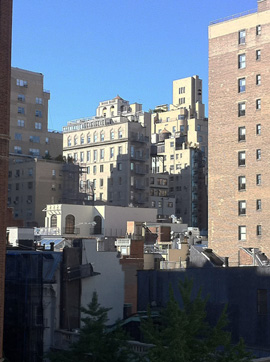Approaching Home
John Haberin New York City
Marc Camille Chaimowicz and Zoe Leonard
Marc Camille Chaimowicz did not choose his residence on Approach Road for the street address, but he must have relished it. A seasoned conceptual and appropriation artist, he would not have minded the redundancy in the name. A designer who has built a career on remaking his apartment, both there and elsewhere, he would have known that he is always approaching and never altogether there.
Then again, he is also always there, and so are you. He once again transplants his home, this time to the Jewish Museum, with any number of changes along the way. It has a coatrack by the entrance, and try not to mind that he has already taken it up with his clothes. It has the fine wood frames of museum doors, preserved from the former Warburg mansion, and terrific views of Central Park across Fifth Avenue. He calls the results "Your Place or Mine . . .," and I am not sure whether to call that a question. With its ellipsis as a marker of the unfinished, I hesitate, too, to call it a retrospective, but it makes itself at home. 
Speaking of roads, Zoe Leonard does not travel light. Even an empty suitcase weighs her down. No wonder the suitcases seem poised never to travel from "Survey," a Whitney retrospective. A work in progress consists of one for each year of her life, extending from an entrance wall. She cannot so easily carry them away, not without destroying the art. Nor can she put them behind her, for she promises to add one more every year.
Here and there
In real life, Marc Camille Chaimowicz has had three London apartments and a home in Burgundy, plus work not on display, and one collage contains the words This Is Not a Flat, with due regard to René Magritte. Still, the show unfolds as a single luxuriant dwelling. From "The Entryway," one reaches "The Library." (Those who miss the old layout of the Morgan Library, before the Renzo Piano atrium, will take heart.) Decorative panels occupy a brief resting point as "Here and There," a handy label for his entire life and work. They bear the title Concerto for New York, perhaps an allusion to Homage to New York, the self-destroying sculpture by Jean Tinguely—at home in the city and never at home.
"The Salon" has a new rug and new wallpaper, and "The Public Garden" stays indoors for two final rooms with a view. (All puns and contradictions definitely intended.) The last embraces Central Park, too, in its raised platforms for furniture, supposedly borrowing their curves from the park's drives. Still, it also echoes the Impressionist concern for public parks and private gardens, and it includes a painting by Edouard Vuillard from the museum's collection. The entirety has an old-world gentility that Chaimowicz could never have experienced. His parents, a Polish Jewish mathematician and French Catholic seamstress, escaped the Nazis and never looked back.
They also left Paris for London when the artist, born in 1947, was eight years old, and he titles the rooms in French. Again, he is mixing memory, desire, and present experience, while wondering whether and where he has arrived. He also calls the wallpaper Vasque (or "cauldron"), and he begins with the library in order to present his sources. A style magazine featured his home, and he in turn cuts up and reassembles its pages as a work of art, World of Interiors, the very name of the magazine. Its text allows him to refer to himself in the third person, as in "while he's away." And its photos allow him to show off his design sense while tearing them apart.
That design sense is evident everywhere, as curated by Kelly Taxter, and so is the underlying unease. The garden apartment also draws on the museum for a clock by Adolf Loos, the Austrian designer, but Chaimowicz created everything else, from a sofa and coffee table to a lampshade and magazine rack. Much of it looks back to Loos anyway, at the very dawn of Modernism. Even when the mixed media include an ad for "TV for the modern home," the TV in the picture is anything but contemporary. I could swear that a couch requires lying on one's back, as if for Sigmund Freud. Which memories, it seems to ask, are accurate, and which are voluntary?
Not everything is as much fun as first appears. A piano stool stands in for a desk chair, and Desk on Decline is missing a leg. A stiff chair could be a throne or a highchair for a stubborn child. The colors in that patterned rug may resolve into lips and a broken heart. Seven Day Hat Rack suggests a weekly routine that repeats itself with no end in sight. A green mirror on the show's last wall looks like a door onto something more expansive, while only looking back.
As for Freud, much here points to sex—all the more so in the library, with perfume ads and quotations from Lou Reed's Berlin, André Gide's The Immoralist, and Jean Genet's The Thief's Journal. Then, too, Loos titled an essay "Ornament and Crime." The men in photographs looking wistfully away could be Chaimowicz posing for the style magazine or objects of desire. As a gay artist on museum mile, he has every reason to feel never quite at home. Still, pleasures drift elusively in and out his designs, painting, and drawings. A remnant of the 1970s London art scene, he may not have had much of a presence in New York, but he has the most elegant spot on museum mile.
Everywhere and nowhere
Just a few years ago, MoMA turned over its daunting atrium to Zoe Leonard, for her Analogue. Its four hundred color photos took her from the Lower East Side to Eastern Europe, Africa, Cuba, and Mexico, only to find shuttered storefronts, damaged logos, and obsolete merchandise. It made her the ideal urban explorer with time on her hands, the flaneur of Charles Baudelaire in nineteenth-century Paris, but with nowhere welcoming to go. It left open, too, the object of her explorations. The simplest answer is everything, just as a survey can mean not just an artist's retrospective, here curated by Bennett Simpson with Rebecca Matalon and Elisabeth Sherman, but also a representative sample or a painstaking determination of the boundaries and the lay of the land. A harder answer is nowhere, at least until her gender and sexual orientation find equal acceptance everywhere.
The everywhere and nowhere appear in the blue suitcases along the floor, like steel plates for Carl Andre—or the aerial photos of densely packed suburban homes and railway beds. Leonard's America is a matter of tracts and tracks. They appear nearby, too, in a photo of what looks like the city from above but is only a model New York,  perhaps the one at the Queens Museum. In the work that lends the show its title, Niagara Falls appears thousands of times, but only in postcards stacked on a table. Thousands more line a corridor as You See I Am Here After All, a confession with an uncertain speaker and forever open to doubt. It may matter that the falls do not just attract tourists from all over, but also mark a boundary between nations.
perhaps the one at the Queens Museum. In the work that lends the show its title, Niagara Falls appears thousands of times, but only in postcards stacked on a table. Thousands more line a corridor as You See I Am Here After All, a confession with an uncertain speaker and forever open to doubt. It may matter that the falls do not just attract tourists from all over, but also mark a boundary between nations.
The everywhere and nowhere also apply to the dimension of time. Leonard's model New York still bears the Twin Towers and the postcards the color dyes of a less glossy past. Her fondness for dated materials extends to the grain and awkward highlights of her photographs, even when they document the view from her backyard. They also bear clumsy black and white borders, like an amateur attempt at Richard Avedon. She takes them out of time, too, by reprinting them. Most works bear two or more dates, and the Analogue portfolio now runs to just forty prints at a somewhat larger size.
For all that, she wants to convey the urgency of the political, and for her that means a recreation of America in her image. Old snapshots show her family in New York harbor, where immigrants came to stay. The homes, tracks, and storefronts are her very own America by car, and her camera obscura for the 2014 Whitney Biennial was her eye on museums as real estate. That self-image is a gendered one as well. For I Want a President, she typed a statement or perhaps a poem in support of Eileen Myles, who ran as an "openly female" candidate in 1992. For Strange Fruit that same year, she sewed together the skin from actual fruit, desiccated and empty. It paid tribute in protest to those who have lived and died with HIV, and the title after Billie Holiday's song marks the AIDS crisis as a lynching.
Not that she can stop stepping out of the here and now. She would fit uneasily into the LGBT art of Ulrike Müller or of "Trigger" this past fall at the New Museum. She typed that letter on an old typewriter, and she retained its font when she blew it up to mural size at the High Line in 2016. She photographs a chastity belt and a bearded lady in a bell jar, from a freak show that seems thoroughly remote as well. Stills concerning the civil rights movement belong to a film that she never managed to make. A stack of books may have reached its title's Tipping Point, much like #metoo now, but James Baldwin called his book The Fire Next Time.
Leonard is always testifying but never quite affirming. Her letter demands not a hero but a president with AIDS, without air conditioning, and with experience waiting online at a clinic. Even now, it does not so much argue with claims by Ta-Nehisi Coates that he had, for eight years, found his president as simply ignore them. Other piles of books carry Kodak's How to Take Good Pictures over the course of forty years. She still refuses to take good pictures, and she still refuses to adopt the wheeled suitcases of today. Her America can be haunting and familiar, precisely because it is going nowhere fast.

Marc Camille Chaimowicz ran at the Jewish Museum, through August 5, 2018, Zoe Leonard at The Whitney Museum of American Art through June 10. A related review looks at Leonard in past shows at the Museum of Modern Art and elsewhere.




